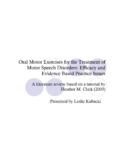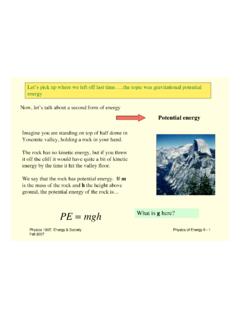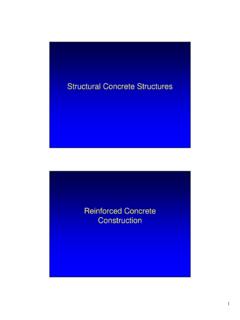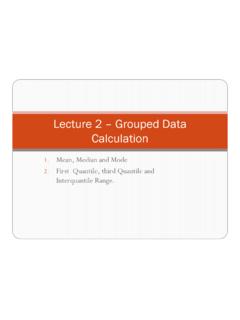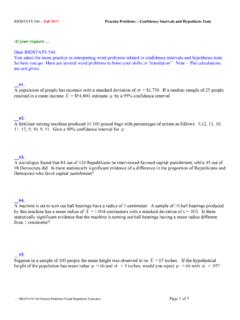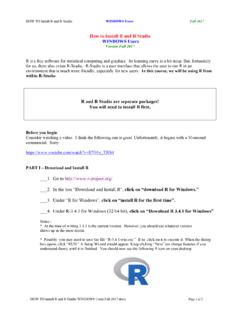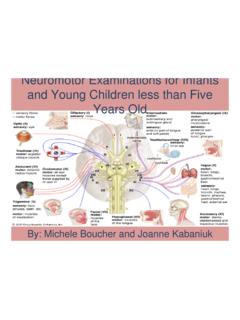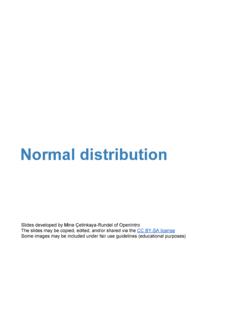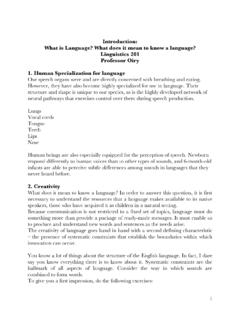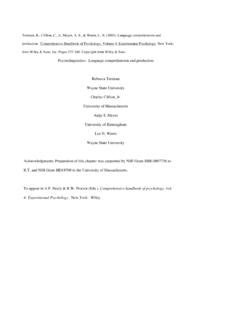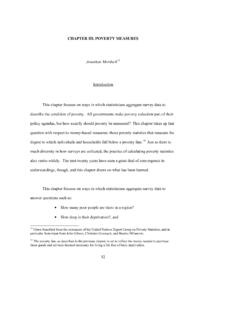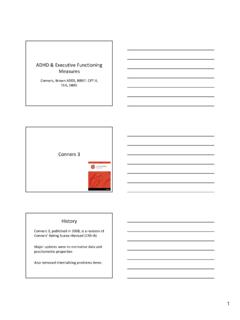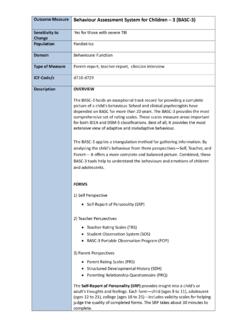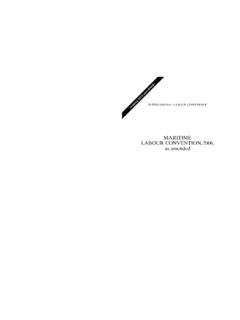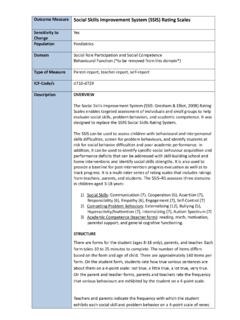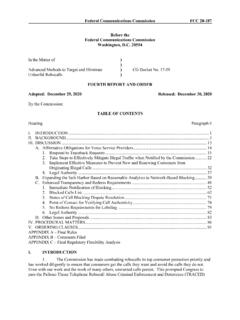Transcription of TPB Questionnaire Construction 1 CONSTRUCTING A THEORY …
1 TPB Questionnaire Construction 1 CONSTRUCTING A THEORY OF PLANNED BEHAVIOR Questionnaire Icek Ajzen Brief Description of the THEORY of Planned Behavior According to the THEORY of planned behavior (TPB), human behavior is guided by three kinds of considerations: beliefs about the likely consequences and experiences associated with the behavior (behavioral beliefs), beliefs about the normative expectations and behaviors of significant others ( normative beliefs), and beliefs about the presence of factors that may facilitate or impede performance of the behavior (control beliefs). In their respective aggregates, behavioral beliefs produce a favorable or unfavorable attitude toward the behavior; normative beliefs result in perceived social pressure or subjective norm; and control beliefs give rise to perceived behavioral control or self-efficacy.
2 The effects of attitude toward the behavior and subjective norm on intention are moderated by perception of behavioral control. As a general rule, the more favorable the attitude and subjective norm, and the greater the perceived control, the stronger should be the person s intention to perform the behavior in question. Finally, given a sufficient degree of actual control over the behavior, people are expected to carry out their intentions when the opportunity arises. Intention is thus assumed to be the immediate antecedent of behavior. To the extent that perceived behavioral control is veridical, it can serve as a proxy for actual control and contribute to the prediction of the behavior in question. The following figure is a schematic representation of the THEORY .
3 TPB Questionnaire Construction 2 The following description of Questionnaire Construction is based on the appendix in Fishbein, M., & Ajzen, I. (2010). Predicting and changing behavior: The reasoned action approach. New York: Psychology Press. Formative Research Defining the Behavior Before any work can begin, the behavior of interest must be clearly defined in terms of its target, action, context, and time elements. Example: Physical Activity We could define exercise behavior as follows (see Terry & O Leary, 1995): Exercising for at least 20 min, three times per week for the next three months. Specifying the Research Population The population of interest to the investigators also must be clearly defined. Example: Post-operative patients In this example, only individuals who have just undergone surgery would be included in the research population.
4 Formulating Items for Reflective (Direct) Measures Five to six items are formulated to assess each of the THEORY s major constructs: Attitude, subjective norm, perceived behavioral control, and intention. Seven-point bipolar adjective scales are typically employed. Sample items assessing intention and each aspect of attitude, subjective norm and perceived control are shown below; additional items and instructions to the participants are shown in the sample Questionnaire (Part II). Participants are asked to circle the number that best describes their personal opinions. Note that the items are formulated to be exactly compatible with the behavioral criterion and to be self-directed. Attitude: Instrumental and experiential aspects My exercising for at least 20 minutes, three times per week for the next three months would be bad :___1__:___2__:___3__:___4__:___5__:___6 __:___7___: good pleasant :___1__:___2__:___3__:___4__:___5__:___6 __:___7___: unpleasant TPB Questionnaire Construction 3 Subjective norm: Injunctive and descriptive aspects Most people who are important to me approve of my exercising for at least 20 minutes, three times per week for the next three months.
5 Agree :___1__:___2__:___3__:___4__:___5__:___6 __:___7___: disagree Most people like me exercised for at least 20 minutes, three times per week in the three months following their major surgery unlikely :___1__:___2__:___3__:___4__:___5__:___6 __:___7___: likely Perceived behavioral control: Capacity and autonomy aspects I am confident that I can exercise for at least 20 minutes, three times per week for the next three months. true :___1__:___2__:___3__:___4__:___5__:___6 __:___7___: false My exercising for at least 20 minutes, three times per week for the next three months is up to me disagree:___1__:___2__:___3__:___4__:___ 5__:___6__:___7___: agree Intention I intend to exercise for at least 20 minutes, three times per week for the next three months.
6 Likely :___1__:___2__:___3__:___4__:___5__:___6 __:___7___: unlikely Past behavior In the past three months, I have exercised for at least 20 minutes, three times per week. false :___1__:___2__:___3__:___4__:___5__:___6 __:___7___: true (Note that, in the current example, past behavior may not be a good predictor of future behavior because the past behavior would have occurred prior to the surgery.) Administering a Pilot Questionnaire Eliciting Salient Beliefs A small sample of individuals representative of the research population (post-operative patients) is used to elicit readily accessible behavioral outcomes, normative referents, and control factors. Although the participants can be assembled in groups, the elicitation is done individually in a free-response format.
7 TPB Questionnaire Construction 4 Instructions: Please take a few minutes to tell us what you think about the possibility of exercising for at least 20 minutes, three times per week for the next three months. There are no right or wrong responses; we are merely interested in your personal opinion. In response to the questions below, please list the thoughts that come immediately to mind. Write each thought on a separate line. (Five or six lines are provided for each question.) Behavioral outcomes and experiences (1) What do you see as the advantages of your exercising for at least 20 minutes, three times per week for the next three months? (2) What do you see as the disadvantages of your exercising for at least 20 minutes, three times per week for the next three months?
8 (3) What positive feelings do you associate with exercising for at least 20 minutes, three times per week for the next three months? (4) What negative feelings do you associate with exercising for at least 20 minutes, three times per week for the next three months? normative referents When it comes to your exercising for at least 20 minutes, three times per week for the next three months, there might be individuals or groups who would think you should or should not perform this behavior. (1) Please list the individuals or groups who would approve or think you should exercise for at least 20 minutes, three times per week for the next three months. (2) Please list the individuals or groups who would disapprove or think you should not exercise for at least 20 minutes, three times per week for the next three months.
9 (3) Sometimes, when we are not sure what to do, we look to see what others are doing. Please list the individuals or groups who, after major surgery, are most likely to exercise for at least 20 min, three times per week for the three months following surgery. (4) Please list the individuals or groups who, after major surgery, are least likely to exercise for at least 20 min, three times per week for the three months following surgery. Control factors (1) Please list any factors or circumstances that would make it easy or enable you to TPB Questionnaire Construction 5 exercise for at least 20 min, three times per week for the next three months. (2) Please list any factors or circumstances that would make it difficult or prevent you from exercising for at least 20 min, three times per week for the next three months.
10 CONSTRUCTING Sets of Modal Salient Beliefs A content analysis of the responses to the above questions results in lists of modal salient outcomes, referents, and control factors. These lists are used to construct items to be included in the final Questionnaire , as described below. Selecting Reflective (Direct) Items The pilot Questionnaire , in addition to eliciting salient outcomes and experiences, normative referents, and control factors also includes the items that were formulated to obtain direct measures of attitude toward the behavior, subjective norm, and perceived behavioral control. The data obtained are used to select reliable and valid items for use in the final Questionnaire . Each set of items designed to directly assess a given construct should have a high degree of internal consistency ( , a high alpha coefficient), and the measures of the different constructs should exhibit discriminant validity.
